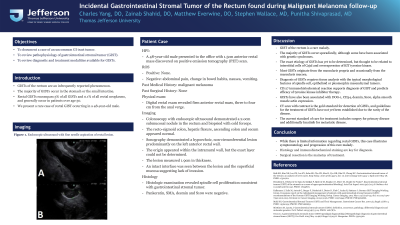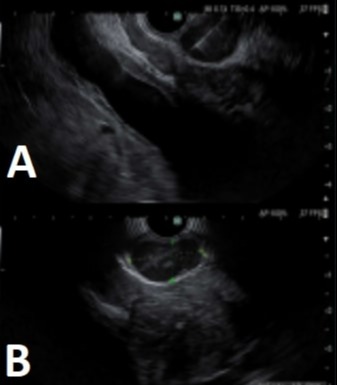Back


Poster Session D - Tuesday Morning
Category: Colon
D0115 - Incidental Gastrointestinal Stromal Tumor of the Rectum Found During Malignant Melanoma Follow-Up
Tuesday, October 25, 2022
10:00 AM – 12:00 PM ET
Location: Crown Ballroom

Has Audio

Charles Yang, DO
Thomas Jefferson University
Voorhees, NJ
Presenting Author(s)
Charles Yang, DO1, Zainab Shahid, DO2, Matthew Everwine, DO3, Stephen Wallace, MD4, Punitha Shivaprasad, DO5
1Thomas Jefferson University, Voorhees, NJ; 2Rowan SOM/ Jefferson NJ/ Virtua OLOL, Stratford, NJ; 3Thomas Jefferson University, Stratford, NJ; 4Virtua Memorial Hospital-Mount Holly, Camden, NJ; 5Virtua Voorhees, Camden, NJ
Introduction: Gastrointestinal stromal tumors (GISTs) of the rectum are a rarely reported phenomenon. The majority of GISTs occur in the stomach or the small intestine. Rectal GISTs encompass 5% of all GISTs and 0.1% of all rectal neoplasms, and generally occur in people over age 50. We present a rare case of rectal GIST occurring in a 48 year old male.
Case Description/Methods: A 48-year-old male with a history of malignant melanoma presented to the office with 1.5 cm anterior rectal mass discovered on positive emission tomography (PET) scan. He had no complaints and denied rectal bleeding, change in bowel habits and family history of colorectal cancer. Colonoscopy demonstrated a 2.0 cm submucosal nodule in the rectum. Endoscopic ultrasonography confirmed a hypoechoic, non-circumferential lesion predominantly on the left anterior rectal wall. The exact layer could not be determined, and an intact interface was seen between the lesion and the superficial mucosa suggesting lack of invasion. Histologic examination revealed spindle cell proliferation consistent with gastrointestinal stromal tumor. Spindle cells were positive for CD34, CD117 and DOG-1 supporting the diagnosis of GIST. The patient was instructed to follow up with medical oncology for further management.
Discussion: GIST of the rectum is a rare occurrence. The majority of GISTs occur sporadically, although some have been associated with genetic syndromes. The exact etiology of GISTs has yet to be determined but thought to be related to interstitial cells of Cajal and overexpression of KIT tyrosine kinase. Most GISTs originate from the muscularis propria and occasionally from the muscularis mucosa. Diagnosis of GISTs requires tissue analysis with the typical morphological features of spindle cell, epithelioid or pleomorphic mesenchymal tumors. CD117 immunohistochemical reaction supports diagnosis of GIST and predicts efficacy of tyrosine kinase inhibitor therapy. GISTs have also been associated with DOG-1, CD34, desmin, S100, alpha smooth muscle actin expression. CT scan with contrast is the gold standard for detection of GISTs, and guidelines for the treatment of GISTs have not yet been established due to the rarity of the disease. The current standard of care for treatment includes surgery for primary disease and additionally Imatinib for metastatic disease. While there is limited information regarding rectal GISTs, this case illustrates symptomatology and progression of this rare malady.

Disclosures:
Charles Yang, DO1, Zainab Shahid, DO2, Matthew Everwine, DO3, Stephen Wallace, MD4, Punitha Shivaprasad, DO5. D0115 - Incidental Gastrointestinal Stromal Tumor of the Rectum Found During Malignant Melanoma Follow-Up, ACG 2022 Annual Scientific Meeting Abstracts. Charlotte, NC: American College of Gastroenterology.
1Thomas Jefferson University, Voorhees, NJ; 2Rowan SOM/ Jefferson NJ/ Virtua OLOL, Stratford, NJ; 3Thomas Jefferson University, Stratford, NJ; 4Virtua Memorial Hospital-Mount Holly, Camden, NJ; 5Virtua Voorhees, Camden, NJ
Introduction: Gastrointestinal stromal tumors (GISTs) of the rectum are a rarely reported phenomenon. The majority of GISTs occur in the stomach or the small intestine. Rectal GISTs encompass 5% of all GISTs and 0.1% of all rectal neoplasms, and generally occur in people over age 50. We present a rare case of rectal GIST occurring in a 48 year old male.
Case Description/Methods: A 48-year-old male with a history of malignant melanoma presented to the office with 1.5 cm anterior rectal mass discovered on positive emission tomography (PET) scan. He had no complaints and denied rectal bleeding, change in bowel habits and family history of colorectal cancer. Colonoscopy demonstrated a 2.0 cm submucosal nodule in the rectum. Endoscopic ultrasonography confirmed a hypoechoic, non-circumferential lesion predominantly on the left anterior rectal wall. The exact layer could not be determined, and an intact interface was seen between the lesion and the superficial mucosa suggesting lack of invasion. Histologic examination revealed spindle cell proliferation consistent with gastrointestinal stromal tumor. Spindle cells were positive for CD34, CD117 and DOG-1 supporting the diagnosis of GIST. The patient was instructed to follow up with medical oncology for further management.
Discussion: GIST of the rectum is a rare occurrence. The majority of GISTs occur sporadically, although some have been associated with genetic syndromes. The exact etiology of GISTs has yet to be determined but thought to be related to interstitial cells of Cajal and overexpression of KIT tyrosine kinase. Most GISTs originate from the muscularis propria and occasionally from the muscularis mucosa. Diagnosis of GISTs requires tissue analysis with the typical morphological features of spindle cell, epithelioid or pleomorphic mesenchymal tumors. CD117 immunohistochemical reaction supports diagnosis of GIST and predicts efficacy of tyrosine kinase inhibitor therapy. GISTs have also been associated with DOG-1, CD34, desmin, S100, alpha smooth muscle actin expression. CT scan with contrast is the gold standard for detection of GISTs, and guidelines for the treatment of GISTs have not yet been established due to the rarity of the disease. The current standard of care for treatment includes surgery for primary disease and additionally Imatinib for metastatic disease. While there is limited information regarding rectal GISTs, this case illustrates symptomatology and progression of this rare malady.

Figure: Endoscopic ultrasound with fine needle aspiration of rectal lesion.
Disclosures:
Charles Yang indicated no relevant financial relationships.
Zainab Shahid indicated no relevant financial relationships.
Matthew Everwine indicated no relevant financial relationships.
Stephen Wallace indicated no relevant financial relationships.
Punitha Shivaprasad indicated no relevant financial relationships.
Charles Yang, DO1, Zainab Shahid, DO2, Matthew Everwine, DO3, Stephen Wallace, MD4, Punitha Shivaprasad, DO5. D0115 - Incidental Gastrointestinal Stromal Tumor of the Rectum Found During Malignant Melanoma Follow-Up, ACG 2022 Annual Scientific Meeting Abstracts. Charlotte, NC: American College of Gastroenterology.
